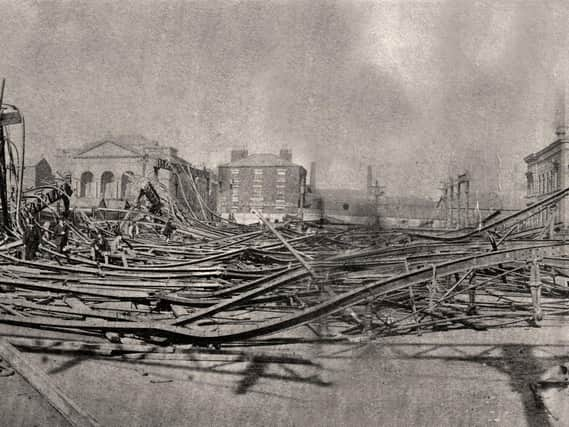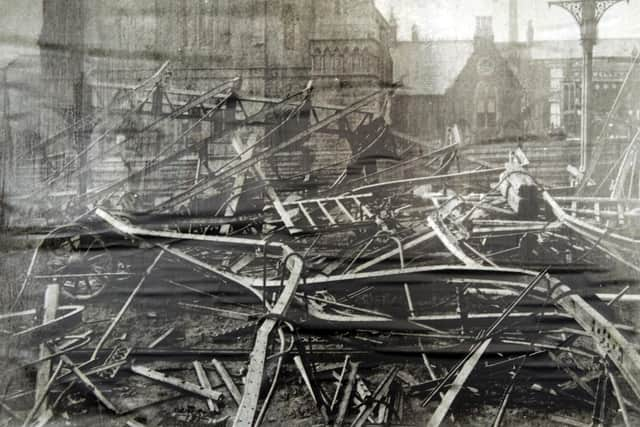Dramatic moment when Preston market's roof collapsed


The accident happened on August 6, 1870 at 7.30am when the structure fell inward, bringing the newly constructed pillars and expanse of roof crashing down. Fortunately, no one was killed in the incident, which brought crowds of people on to the town centre streets.
Work had been underway to build the covered market for four months on the site of a former orchard at Colley’s Gardens, with the aim to be open by the autumn of 1870.
Advertisement
Hide AdAdvertisement
Hide AdAlong each side of the 355ft long and 101ft wide space 50 pillars had already been put in place to hold up the roof when, without warning the girders, suddenly gave way from the top.


The movement buckled and dragged down 32 of the iron pillars, with many smashed from their pedestal with a force which ripped up the foundations.
There were 10 builders working on the site at the time, five on the ground five in the canopy who clung on as the framework bent slowly before toppling. But as they reached the ground they found themselves surrounded by ironwork.
That day’s Preston Chronicle newspaper reported: “One or two men, seeing the danger of their position when the principals gave way, made preparations for jumping to the ground, but they were dissuaded from this, and luckily so, for if they had made a descent while the ironwork was falling they might have been caught underneath it afterwards.”
Advertisement
Hide AdAdvertisement
Hide AdHowever, a worker called Thomas Bateson, of Wells Street, Preston, was not so lucky and he was badly crushed around the legs and body and had to be taken to Preston Infirmary in a cab.
A second worker named as James Barrow described to the Chronicle how he had a narrow escape.He was on the ground when the iron fell and managed to dash out of the way just in time to avoid what would have been certain death.
None of the structure fell outside of the hoarding surrounding the building site although some pillars were left leaning over public places.
Early estimates put the cost of the damage at £2,000, which would fall to Preston-based contractor Joseph Clayton. The Guardian reported: “The market now presents a scene of complete wreck. Huge smashed pillars, broken girders and principals, twisted in all directions lie in the centre all mixed up in the greatest confusion.
Advertisement
Hide AdAdvertisement
Hide Ad“During the whole of the morning, crowds have collected around the hoarding for the purpose of getting sight of the wreck which has taken place. The accident will prevent completion of the market for some months to come. The probability is that it will be near the year end before it is finished.
“As to the cause of the accident, there are various conjectures, the most likely of then being wither the plates of the roof were not sufficiently strong to resist the vibrations of the principals or they must have been a flaw in one of the pillars.”
Talks and planning for a covered market had taken place for more than 30 years with civic leaders keen to provide a facility to rival any other in the region. It was essential the site would be able to house all of the market’s stalls while also allowing carts to easily move around inside.
The contract for the building of the covered market had been awarded to by Joseph Clayton, of the Soho Foundry, in February 1870 for £6,070. But after the collapse he gave up the contract, declaring that no roof made on that principle would stand rough weather.
Advertisement
Hide AdAdvertisement
Hide AdMessrs Bennett Co, of Birmingham, then undertook the work for £9,000, but they also gave it up, alleging a similar objection. Its construction was finally undertaken by ship builders Messrs Allsup and Sons of Preston in May 1872, and they completed it at a cost of £9,126 in 1875.
The Grade II listed structure still remains and three of the column bases are marked J. Clayton Preston, the other 27 are marked W Allsup Preston 1875.
Comment Guidelines
National World encourages reader discussion on our stories. User feedback, insights and back-and-forth exchanges add a rich layer of context to reporting. Please review our Community Guidelines before commenting.